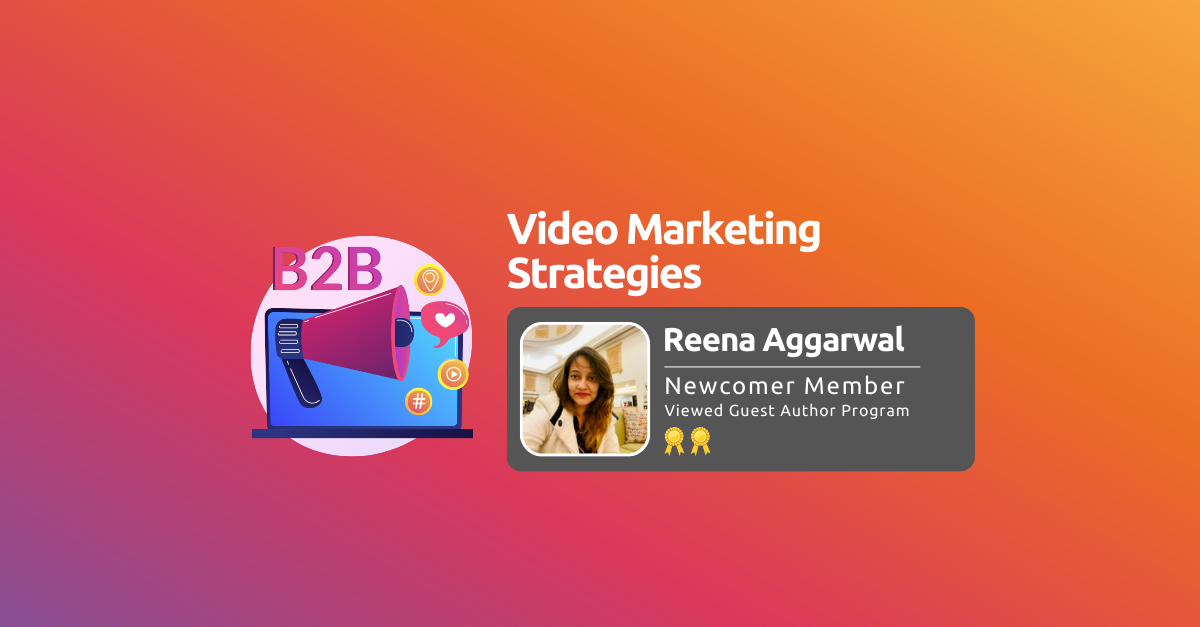With strong visual elements, video marketing can transform your brand's reach and impact in the online marketplace.
Recent statistics by Google reveal that 68% of YouTube users rely on the platform for their purchasing decisions, of which seven of ten will buy from a brand they see. With this in mind, standing out from competitors means creating a video marketing strategy. This way, you will have more eyes on your product, including your potential buyers, who will eventually connect to your brand and increase leads.
So, here’s how to create a video marketing strategy.
1. The Importance of Video Marketing Strategy
As video-creating gets easier, accompanied by the rise of smartphone use, video marketing is becoming popular, hence the need to invest in a strategy. A video marketing strategy is also integral to B2B businesses aiming at fast growth. With an effective strategy, you will engage your audience, educate prospective buyers through product demos, and influence their decisions through customer testimonials and webinars.
Other benefits of a video marketing strategy for companies include the following:
- Increases social shares and engagement
- Is great for mobile users. As of March 2023, it was reported that nearly 70 percent of digital video content viewers in the United States preferred using their smartphones for this purpose.
- Generates B2B leads and Improves overall SEO performance. Engaged viewers will increase your conversions, and what better way than creating value-packed videos and webinars requiring them to sign up?
- Helps build trust and educate your audience.
- Is effective with account-based marketing (ABM) as you can send your customers customized content.
No matter the size of your business, having a marketing strategy will help you attain your business objectives. For a successful campaign, define your target group, select a video tool and platform, define your video length, create a script, and develop a powerful video title.
2. How to Build a Video Marketing Strategy
Building a video marketing strategy requires proper research and a plan. Your strategy will define your budget, timelines, production process, and conversion metrics. The following are steps to building a video marketing strategy.

2.1. Understand Your Target Audience
Figuring out who you want to watch your video ensures you develop a strategy that makes them watch. Map out your buyer persona to ensure those who want to buy your product watch your videos. If you have an existing persona, update it to include your recent videos.
2.2. Set Campaign Goals
A successful video marketing campaign requires research of the people you are targeting and the goals you want to achieve. Whether driving sales, awareness, or traffic, spend time researching, as this will inform the kind of videos you make and the budget you will spend on them.
Creating awareness defines your opportunity and helps your viewers realize they have a problem. At this stage, aim for videos that attract your target audience and introduce your brand to them.
After creating awareness, move to consideration, where the viewer researches, asks for recommendations, and watches your product reviews for a cost-effective solution to their problem. Once your audience finds a solution, your next plan should remain at the top of their mind. Therefore, focus on videos presenting proof of customer satisfaction and why they should choose you over their competitors.
2.3. Set a Budget for Your Video
While a creative strategy and planning are vital, a proper budget is crucial to get what you want. Plan with what you have for all the activities in the strategy, including the content you will shoot in-house, those you will outsource, what you can splurge, and the ones you want to save on.
2.4. Set up a Timeline
As you plan your video production, have a timeline to stick to, including the overall distribution and production timelines. These timelines are a guiding light and will keep you tabs on how much you have done and what remains. Keep your team members informed about timelines, schedules, completion dates, and changes.
2.5. Select the Best Platform for Video Distribution
Choosing a platform to distribute your videos is crucial as it needs to align with what the audience on the platform is seeking. Therefore, consider the following:
- Size and sound limitations.
- Average view time.
- Budget.
- Communities.
- Promotion.
Remember, even though we use videos for advertising, it's not instantaneous. Some platforms have built-in features for promotions, while others will require you to dedicate time and effort to get more views.
Email Marketing to Amplify Your Reach
While many associate video distribution primarily with platforms like YouTube, don't underestimate the power of email marketing. Incorporating videos into your email campaigns can be an effective strategy to reach your audience directly. Through video in email, you can promote products or premium content, providing your subscribers with a special experience.
Unlock the Power of Video in Your Emails: Visit www.viewed.video to discover how to add and play videos in your emails, taking your messages to the next level!
The advantage of email marketing lies in its ability to reach individuals personally, avoiding the saturation of other platforms. Additionally, you can segment your audience and send specific video content based on their preferences, achieving a more direct and effective connection.
2.6. Choose the Right Video Type
Upon settling on the platforms and what you want to communicate, choose the right video type as follows:
- Event Videos: Event videos are ideal for capturing your events, including congresses, exhibitions, and celebrations. Your attendees will remember the company, while absentees can picture their expectations in future events.
- Expert Interviews: Expert interviews answer your audience's pressing questions. You can engage a thought leader or team member for a chat or produce a solo video where they respond to questions submitted earlier on. Recording your interview in advance or doing a live recording is also helpful in making your audience heard and seen.
- Product Demos: A product demo aims at attracting new customers in the first stage of product search. These videos, usually 30 seconds long, inform your audience of your best-selling products and demonstrate the product in action, helping to build consumer confidence in your brand. In your product demo video, show your product's utility, necessity, and what makes it better than your competitor’s.
- How-To Videos: How-to videos are problem-solving videos centered on an objective. These videos have a step-by-step guide on meeting the objective and should answer common concerns about a service or product.
- Explainer Videos: Explainer videos teach your audience about your product, service, or brand. These videos focus on how you solve a problem and will serve well as your brand introductions. Maintain these videos short and capture your audience's problem, how your service or product will fix it, and why your audience should consider you.
- Customer Testimonials and Case Studies: Testimonials display past and present customer experience using your products or services. These videos are a stronger way to influence new customers, and you can use the reviews to increase your credibility and convince your prospects. Customer testimonial videos should be up to two minutes maximum, and you can publish them anywhere as long as the individual captured in the video is authentic. Case study videos aim to convert potential clients by demonstrating your expertise and your achievements to other persons like them. These videos are ideal at the middle and bottom of your sales funnel for better results.
- Live Streams: Through social media platforms, businesses can create live streams to engage with their prospective clients in real time. Use live streams for announcements, interviews, events, and office tours. Your customers will post their questions on the chats, and you should address and engage with them during the stream.
- Personalized Messages: As the name suggests, personalized videos speak to the direct needs of the target audience. A video targeted to a specific individual or client will capture their attention and engage them, hence a higher probability of watching up to the end.
Customize Your Message, Delight Your Audience: Discover the Impact of 1-to-1 Personalized Videos in Your Emails. Transform Your Users' Experience!
2.7. Develop Your Video Content
Videos are an essential channel for marketers. However, what makes your video great and your viewers engaged? Here are tips on how to develop your video content.
- Know your target audience and create customized content
- Focus more on stories that viewers can connect to and know what your company can do for them
- Capture your viewers’ attention in the first few seconds
- Clearly define your video goals
- With the short human attention span, keep your videos short
- Include a call to action at the end
- Optimize your videos for search through SEO in your video descriptions
- Collaborate with influencers and other brands
2.8. Track Your Video Marketing Metrics
Tracking your video marketing metrics will help you figure out what is working out and what is not. To test your marketing success, check the following:
- Engagement rate: The engagement rate measures the interactions your prospects have with your video, including how much time they spent watching, whether they watched up to the end or not, and if they skipped through the video. This number will give you an idea of your video quality, creativity, message, and whether it is the right length.
- View Count: View count is the number of times your audience watches your video and varies across platforms. For instance, a view on YouTube is 30 seconds, and 3 seconds on Facebook. Learn how each platform measures the view count to understand your viewers’ interactions with your content across platforms. This way, you will determine the engagement and better plan your content and campaign.
- Average Watch Time: The average watch time is the total time people have watched your videos divided by the number of video plays and replays. Average watch time helps you understand if your content resonates with your audience. A longer time means they enjoy it, while a shorter one could indicate you missed the mark.
- Clickthrough Rate (for Social Media and Emails): The clickthrough rate equals the number of clicks on your hyperlink, image on your email content, or call to action. Such videos aim to get many people to click on your videos, maybe leading them to your landing page to learn more about your product or service. Using the clickthrough rate, you can rate your performance on link placement, media type, link count, email content, and overall brand interest.
- Social Media Engagement: Social media engagement is measurable through the views, likes, shares, and comments on your video. Pay attention to the kind of reactions your videos receive, whether likes or dislikes and the discussions by your viewers in the comment sections.
3. Use Video Marketing Strategy
Creating a video marketing strategy can be overwhelming, but with proper planning, you will produce and sell content unique to your brand. With the above steps and considerations, you can start with simple equipment like your smartphone camera and grow your business.





